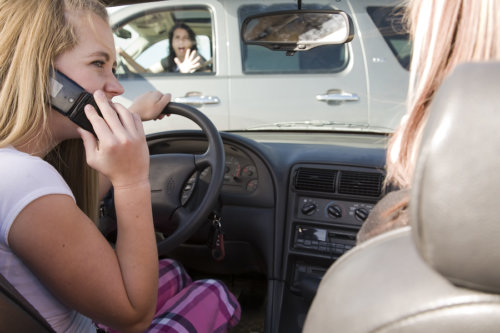You may think that today’s motor vehicle safety features would help mitigate driving dangers and protect people from serious injury or death. However, as USA Today reports, technology cannot control all risks, and unsafe driving behaviors often contribute to auto accidents in the United States.
If you've found yourself in a car accident due to the negligent actions of another driver, it's crucial to seek the right legal assistance to navigate through the complexities of your case. If you've experienced such a situation and are seeking a trusted legal advocate in the Bronx, our expert team is here to help. Contact our experienced Bronx car accident lawyers today to ensure you receive the compensation you deserve. Don't let the aftermath of a car accident overwhelm you—let us fight for your rights and guide you towards a fair resolution. Your peace of mind is just a call away.
Driver actions that lead to accidents fall into eight general categories, discussed in more detail below.
No. 1: Drivers Often Do More Than Just Drive

Driving demands 100 percent of a motorist’s attention, but many drivers underestimate how non-driving activities distract them from the important task of driving. The National Highway Transportation Safety Administration (NHTSA) reports that distracted driving accidents killed over 2,800 people in 2018. AAA adds that drivers double their risk of an accident when they divert their attention from the road for even only two seconds.
The Centers for Disease Control and Prevention (CDC) categorizes driving distractions as visual, manual, and cognitive. Visual distractions occur when drivers take their eyes off the road, manual distractions occur when drivers take their hands off the wheel, and cognitive distractions occur when drivers allow their minds to wander. Using a phone while driving is a key cause of distracted driving. Sending or reading a text can cause drivers to look away from the road for five seconds, which, at 55 miles per hour, is comparable to driving the length of a football field with their eyes closed.
The AAA Foundation for Traffic Safety reports that in-vehicle technology systems may also cause distractions, as drivers adjust their audio devices or program their navigation systems. Older drivers in particular may find it challenging to master technologies, like touch screens, that require drivers to look away from the road.
Of course, there are also “low-tech” distractions that may interfere with driving. Drivers are more likely to turn their attention away from the road when they are sipping hot coffee, applying mascara, or reaching for something they’ve dropped.
No. 2: Motorists Take Risks With Red Lights
The AAA Foundation for Traffic Safety conducted an analysis that showed an increasing number of fatalities arising from drivers who run red lights. This study revealed that in 2017, deaths caused by red-light running reached a 10-year high, and almost half of the victims were in vehicles struck by the car running the light. Drivers are generally more likely to take risks and enter an intersection after a light turns red if they believe that their actions will go undetected by law enforcement or a red light camera.
No. 3: The Socially Accepted Problem of Speeding
Speeding has historically accounted for one-third of roadway fatalities in the U.S., according to the Governors Highway Safety Association. Unfortunately, both motorists and policymakers tend to discount the dangers of speeding. Drivers who speed are at greater risk of losing control of their cars, and they may also find longer stopping times as they approach changing lights or looming hazards. Crashes caused by speeding drivers may impact other vehicles, as well as pedestrians, bicyclists, and road construction workers.
The NHTSA explains that speeding extends beyond drivers that go faster than the posted speed limit. Speeding also includes driving too fast for conditions. Bad weather or road construction may create conditions that make it prudent to drive at a speed slower than the posted limit.
No. 4: Aggressive Behavior Takes Many Forms
The Insurance Information Institute explains that while speeding and disregarding red lights may fall into the category of aggressive driving, aggressive drivers may also exhibit other dangerous behaviors. For example, these drivers may make erratic lane changes, follow too closely, pass in non-passing zones, fail to yield rights-of-way, or generally drive in a reckless or careless manner.
No. 5: Alcohol and Drugs May Impair a Driver’s Judgment
Motorists who drive with their abilities impaired by alcohol or drugs pose grave risks on the roads. Indeed, the NHTSA reports that in 2017, alcohol-impaired drivers caused 30 percent of auto accident deaths in New York. The Insurance Institute for Highway Safety explains that alcohol may impair a driver’s judgment, including the ability to anticipate hazards and react properly. In addition, alcohol may impact a driver’s coordination, concentration, and vision.
Drugged driving also poses dangers on the road. The National Institute on Drug Abuse describes many different drugs that may affect driving skills. For example, a drug like cocaine may cause someone to drive aggressively and recklessly, while a drug like marijuana can slow reaction time and interfere with coordination. Even prescription drugs can get in the way of safe driving, and this risk is greater among older drivers. A study by the AAA Foundation for Traffic Safety found that some prescribed medications increase the risk of accidents by up to 300 percent, as drivers experience blurred vision, fatigue, or confusion.
No. 6: Impaired Driving May Also Take the Form of Sleep Deprivation
Forbes reports that driver drowsiness may account for around 330,000 motor vehicle accidents in the U.S. each year, and 16 percent of fatal crashes. A driver becomes increasingly impaired with each hour of sleep deprivation. Researchers compared the accident risk posed by drivers who sleep seven to nine hours nightly to the accident risk of their sleep-deprived counterparts.
Drivers who sleep six hours are 1.3 times more likely to cause a crash, and drivers who try to function on fewer than four hours of sleep are 15.1 times more likely to cause a crash. In fact, motorists who get behind the wheel after fewer than four hours of sleep pose a roadway risk comparable to a driver whose blood alcohol level is 1.5 times the legal limit.
No. 7: Driver Behavior Can Make Weather Conditions Even Trickier
Weather-related incidents account for roughly 21 percent of motor vehicle crashes each year. A study by the Federal Highway Administration cites wet pavement, rain, snow, icy pavement, and fog as the leading causes of these incidents. While the weather can independently contribute to accidents, driver habits like speeding and following too closely for conditions can worsen an already dangerous situation and increase the likelihood of a crash.
No. 8: Inexperience Constitutes a Driving Hazard
According to the CDC, inexperience may play a role in auto accidents. Teen drivers in particular may lack the judgment to act appropriately when forced to make quick decisions or avoid a road hazard. Newly-licensed drivers have a higher crash rate per mile, and 16-year-olds have a crash rate 1.5 times higher than the crash rate for 18- and 19-year-old drivers.
Driver actions may lead to accidents that cause serious injury or death. If you or a family member has suffered harm in an auto accident, consult a lawyer with experience in car accident cases.



